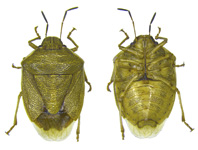Abstract
The systematics of the dart-poison frogs, family Dendrobatidae, experienced several taxonomic rearrangements over time (e.g., Grant et al. 2006, 2017; Brown et al. 2011). Currently, this family comprises 194 described species organized in three sub-families and 15 genera (Frost 2018). Among them, the genus Adelphobates Grant, Frost, Caldwell, Gagliardo, Haddad, Kok, Means, Noonan, Schargel, & Wheeler, 2006, comprises three species, all distributed in Central and lower Amazon drainage of Peru and Brazil, and possibly in northeast of Bolivia (Grant et al. 2006; Frost 2018). Adelphobates galactonotus (Steindachner 1864) is an endemic Brazilian frog, and can be found throughout Pará, Maranhão, Mato Grosso and Tocantins states (Hoogmoed & Avila-Pires 2012), related to Amazon forest formations and also in transitional areas between the Cerrado and the Amazon forest (Valdujo et al. 2012). Despite this species is classified as Least Concern (Rodrigues et al. 2010), several threats are known. First, its geographic distribution coincides with the so-called Amazonian Deforestation Arc, which comprehends the southeastern portion of the Amazonian Forest that has been rapidly converted into pasture and crop areas or being flooded due to the construction of hydroelectric power plants (Hoogmoed & Avila-Pires 2012). Also, this species is present in Appendix II of CITES as a target for illegal trade, and their commercial exploitation should be controlled to avoid that this species become seriously endangered in the near future (see a case study in Paula et al. 2012). These threats are of deeper concern because despite A. galactonotus has been described since more than 150 years (Steindachner 1864), its tadpole remains unknown. Without a better understanding of the natural history of A. galactonotus, attempts of conservation strategies and population management are inefficient. In an effort to fill the knowledge gaps about this species natural history, we present a detailed description of the external morphology of the A. galactonotus tadpole.
References
Altig, R. & McDiarmid, R.W. (1999) Body plan: development and morphology. In: McDiarmid, R.W. & Altig, R. (Eds.), Tadpoles: The Biology of Anuran Larvae. The University of Chicago Press, Chicago, pp. 24–51.
Anganoy-Criollo, M. (2013) Tadpoles of the high-Andean Hyloxalus subpunctatus (Anura: Dendrobatidae) with description of larval variation and species distinction by larval morphology. Papéis Avulsos de Zoologia, 53, 211–224.
https://doi.org/10.1590/S0031-10492013001500001Brown, J.L., Twomey, E., Amezquita, A., de Souza, M.B., Caldwell, J.P., Lotters, S., Von May, R., Melo-Sampaio, P.R, Mejia-Vargas, D., Perez-Pena, P., Pepper, M., Poelman, E.H., Sanchez-Rodriguez, M. & Summers, K. (2011) A taxonomic revision of the Neotropical poison frog genus Ranitomeya (Amphibia: Dendrobatidae). Zootaxa, 3083, 1–120.
Caldwell, J.P. & Myer, C.W. (1990) A new poison frog from Amazonian Brazil, with further revision of the quinquevittatus group of Dendrobates. American Museum Novitates, 2988, 1–21.
Castillo-Trenn, P. (2004) Description of the tadpole of Colostethus kingsburyi (Anura: Dendrobatidae) from Ecuador. Journal of Herpetology, 38, 600–606.
https://doi.org/10.1670/40-04NFrost, D.R., Grant, T., Faivovich, J., Bain, R., Haas, A., Haddad, C.F.B., de Sá, R.O., Donnellan, S.C., Raxworthy, C.J., Wilkinson, M., Channing, A., Campbell, J.A., Blotto, B.L., Moler, P., Drewes, R.C., Nussbaum, R.A., Lynch, J.D., Green, D. & Wheeler, W.C. (2006) The amphibian tree of life. Bulletin of the American Museum of Natural History, 297, 1–370.
https://doi.org/10.1206/0003-0090(2006)297[0001:TATOL]2.0.CO;2Frost, D.R. (2018) Amphibian Species of the World: An online reference. Version 6. American Museum of Natural History, New York. Available from: http://research.amnh.org/herpetology/amphibia/index.php (accessed 20 February 2018)
Gosner, K.L. (1960) A simplified table for staging anurans embryos and larvae with notes on identification. Herpetologica, 16, 183–190.
Grant, T., Frost, D.R., Caldwell, J.P., Gagliardo, R., Haddad, C.F.B., Kok, P.J.R., Means, B.D., Noonan, B.P., Schargel, W. & Wheeler, W.C. (2006) Phylogenetic systematics of dart-poison frogs and their relatives (Anura: Athesphatanura: Dendrobatidae). Bulletin of the American Museum of Natural History, 299, 1–262.
https://doi.org/10.1206/0003-0090(2006)299[1:PSODFA]2.0.CO;2Grant, T., Rada, M., Anganoy-Criollo, M., Batista, A., Dias, Pedro Henrique., Jeckel, A.M., Machado, D.J. & Rueda-Almonacid, J.V. (2017) Phylogenetic Systematics of Dart-Poison Frogs and their Relatives Revisited (Anura: Dendrobatoidea). South American Journal of Herpetology, 12, 1–90.
https://doi.org/10.2994/SAJH-D-17-00017.1Haas, A. (2003) Phylogeny of frogs as inferred from primarily larval characters (Amphibia: Anura). Cladistics, 19, 23–89.
Hennig, W. (1966) Phylogenetic Systematics. University of Illinois Press, Urbana, IL, 280 pp.
Hoogmoed, M.S. & Avila-Pires, T.C.S. (2012) Inventory of color polymorphism in populations of Dendrobates galactonotus (Anura: Dendrobatidae), a poison frog endemic to Brazil. Phyllomedusa, 11, 95–115.
https://doi.org/10.11606/issn.2316-9079.v11i2p95-115Myers, C.W., & Daly, J.W. (1980) Taxonomy and ecology of Dendrobates bombetes, a new Andean frog with new skin toxins. American Museum Novitates, 2692, 1–23.
Rodrigues, M.T., Azevedo-Ramos, C. & Hoogmoed, M. (2010) Adelphobates galactonotus. The IUCN Red List of Threatened Species. International Union for the Conservation of Nature, Cambridge, UK. Available from: http://www.iucnredlist.org (accessed 5 February 2018)
Paula, C.D., Pacífico-Assis, E.C. & Catão-Dias, J.L. (2012) Batrachochytrium dendrobatidis in amphibians confiscated from illegal wildlife trade and used in an ex situ breeding program in Brazil. Diseases of Aquatic Organisms, 98, 171–175.
https://doi.org/10.3354/dao02426Sánchez, D.A. (2013) Larval morphology of Dart-Poison Frogs (Anura: Dendrobatoidea: Aromobatidae and Dendrobatidae). Zootaxa, 3637, 569–591.
Steindachner, F. (1864) Batrachologische Mittheilungen. Verhandlungen des Zoologisch-Botanischen Vereins in Wien, 14, 239–288.
Silverstone, P.A. (1975) Two new species of Colostethus (Amphibia: Anura: Dendrobatidae) from Colombia. Los Angeles County Museum Contributions in Science, 268, 1–10.
Valdujo, P.H., Silvano, D.L., Colli, G. & Martins, M. (2012) Anuran species composition and distribution patterns in Brazilian Cerrado, a neotropical hotspot. South American Journal of Herpetology, 7, 63–78.
https://doi.org/10.2994/057.007.0209

